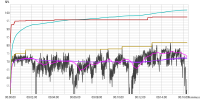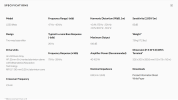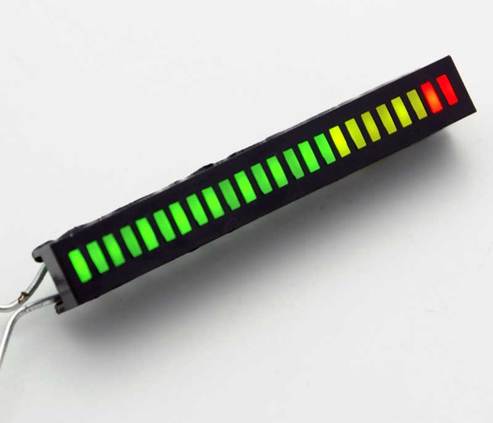This is a review and detailed measurements of the Topping B100 "monoblock" amplifier. It was sent to me by the company and costs US $299.
View attachment 392530
I was surprised by the desktop/low profile of the amplifier. I expected something a lot taller/chunkier especially since this is a class B amplifier and not class D. Power supply is of course external:
View attachment 392531
Nice to see balanced input, three gain settings and trigger input.
The front panel power button is touch sensitive. You have to learn to just touch and remove your finger for it to power on. When it goes into protection, you have to hold it until error codes disappear and then touch again for powering up.
A wish for a follow up version is a series of tall color LED bars going from left to right for visual enjoyment. Kind of like this:
If you are not familiar with my
power amplifier audio measurements, please watch this tutorial:
Topping B100 Amplifier Measurements
Let's start with balanced input at low gain:
View attachment 392532
Distortion is vanishingly low at -141 dB. Power supply spikes are taller than it actually. So we are left with noise which is limited by the analyzer. Still, the B100 manages to grab the top spot in our rankings:
View attachment 392538
I know, there is no gain there so let's go up to medium gain:
View attachment 392539
Performance is essentially the same as we again, limited by analyzer inherent noise. This requires a bit higher than 4.5 volt to reach max power. So let's test high gain:
View attachment 392540
Now we see a bit more noise limiting SINAD. But even then, we are better than threshold of hearing.
I hope you are using this amplifier with balanced connection but in case you are not, here are the measurements using RCA at medium and high gains (latter needs less than 1 volt for full power):
View attachment 392541
Edit: this should say high gain, not low:
View attachment 392542
Check out this stunning performance in noise department at 5 watts and max power:
View attachment 392543
View attachment 392544
From here on I will stay with medium gain using XLR balanced input.
View attachment 392545
We can tell from above graph that there is no increase in distortion at higher frequencies. As a result, our 19+20 kHz result remains excellent as well:
View attachment 392546
Not being a class D amplifier, there is no concern regarding load dependency (an issue with some class D amps):
View attachment 392547
The protection circuit is aggressive with 4 ohm load, not allowing the amplifier to go into clipping:
View attachment 392548
This means that if you hear any distortion, it is somewhere else and not in the power amplifier. I tried to measure power at 1% THD but the protection circuit would not allow it. THD would remain incredibly low and then shut down if I increased input voltage. So 86 watts is what you get for max and peak power. Company spec is 83 watts which is an honest assessment. They do spec 100 watts at < 1% THD which I probably could achieve if I tried harder.
Let's not how the B100 blows the competition out of water with respect to noise level. It was so low that I had to move the graph up to see its results above! The analyzer noise actually takes over around 30 watts as it changes its gain to accommodate higher voltage (the step up).
8 Ohm measurement does allow clipping due to lower currents required:
View attachment 392549
Once again we see the massive gap in noise and distortion vs our reference blue line. We are talking 25 dB!
Even more amazing is the fact that B100 maintains its superlative performance at all frequencies, down to 20 Hz!
View attachment 392552
Amplifier is ready on power up although I did overserve a tiny improvement after a few minutes:
View attachment 392550
The amplifier only got modestly warm after the power testing:
View attachment 392551
P.S. I don't have PowerCube measurements for you due to aforementioned aggressive protection circuit, not allowing me to measure peak power.
Edit: forgot the power on/off noise:
View attachment 392594
EDIT 2:
Power Consumption
Standby power consumption is around 1.5 watt. Powered on but not playing, 9.1 watt.
Conclusions
Topping is clearly its own competition, constantly pushing the envelop in noise and distortion. Even when you get used to them delivering on these fronts, they come up with this amplifier where test after test shows excellence in engineering and utmost dedication to highest levels of fidelity. All of this comes in a compact enclosure with a reasonable cost. I have no choice but to bow to their mission and abilities.
It is my absolute pleasure to recommend the Topping B100 monolock amplifier.
------------
As always, questions, comments, recommendations, etc. are welcome.
Any
donations are much appreciated using
: https://www.audiosciencereview.com/forum/index.php?threads/how-to-support-audio-science-review.8150/














